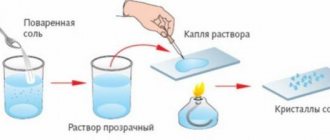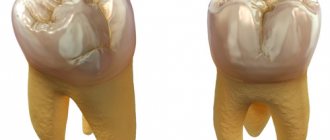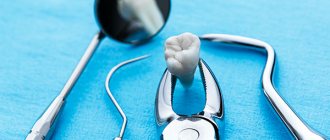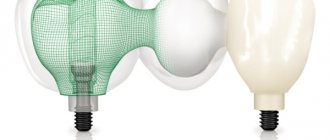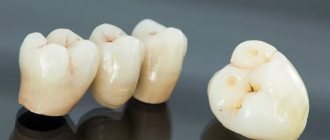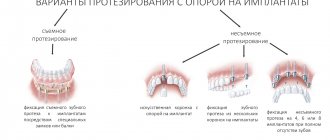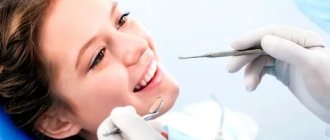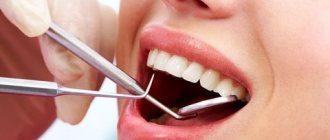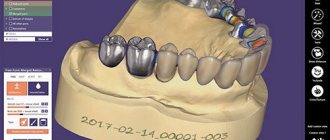If you need to make room before installing orthodontic Invisalign aligners, braces or dentures so that each tooth is in the correct position, separation (interproximal enamel reduction) is performed. The operation is painless, bloodless, minimally traumatic, does not require long-term rehabilitation, but can lead to complications if performed incorrectly on the patient.
What is teeth separation: which doctor does it?
Separation is a technique for expanding the interdental space, during which a thin layer of enamel (no more than 0.25 mm) is removed from the sides of the incisors, thereby freeing up space. Sawing is carried out using a drill, strips, and sometimes a special file is used. Carefully remove the protruding part where the two teeth meet. The procedure is a worthy alternative to extirpation, it allows you to keep your teeth healthy and functional, and
avoids the removal of molars (6, 7 and 8) and other dental units.
Separation of enamel is safe for teeth and does not provoke their hypersensitivity.
Flaws
The procedure has no disadvantages. Many people are scared by the very fact of removing a layer of enamel, however, it is so small that the patient does not even notice the difference before and after the procedure.
The thickness of the enamel reaches 2 millimeters and removal of less than 0.25 millimeters has virtually no effect on its density.
Numerous clinical trials confirm that after the procedure the enamel remains strong and externally undamaged.
During mechanical separation with a bur, the subdental areas of the gums can be damaged; to minimize this possibility, special retainers are used.
With proper preparation for separation, there should be no complications. The main thing is that the procedure must be carried out by a specialist, observing all the necessary requirements.
Important! Before the procedure, it is necessary to treat all teeth and sanitize the oral cavity, achieving maximum destruction of pathogenic flora.
What are the types
There are two ways to carry out separation:
- Mechanical - using a drill with diamond discs, strips or files, a thin layer of enamel (less than 1 mm) is removed from the side surfaces of the incisors.
- Physiological - the interdental spaces expand naturally with the help of wedges, elastic bands, and threads that are inserted into them.
Both methods are practical, but the first method provides instant results. In the second case, you will have to wait several days, so mechanical separation is used more often than physiological separation.
Preparing for surgery
Before separating the dentition, the doctor takes a panoramic photograph of the oral cavity. It allows you to assess the current condition of the latter and identify the presence of hidden pathologies. If necessary, a teleradiogram is additionally prescribed. Next, the doctor makes an impression of the problem area and calculates the course of the future procedure.
In some cases, consultation with a psychologist and osteopath is indicated. These specialists are usually contacted when separation is carried out before installing braces. Such systems create temporary discomfort and worsen the patient’s appearance.
Advantages
The main advantage of the procedure is the ability to preserve healthy teeth. Additional benefits:
- painlessly and quickly frees up space for orthodontic therapy (correction of crowding or malocclusion, jaw prosthetics);
- no long recovery required;
- soft gum tissue is not damaged;
- there is no need for additional treatment of gums (only in the absence of complications);
- the integrity and sensitivity of the teeth is not impaired;
- The operation is performed in one session lasting up to 40 minutes.
Interproximal enamel reduction is only safe when performed by a qualified, experienced dentist. Therefore, you need to carefully choose a clinic and specialist.
Recommendations
After the procedure, as mentioned earlier, no special restorative manipulations are required.
After grinding your teeth, you can apply a special glue to the enamel to protect it. At the patient's request, it is possible to undergo a course of enamel mineralization. Ask a doctor - he will tell you.
There’s no need to remind you, but we’ll remind you anyway. General recommendations for patients:
- It is necessary to undergo regular dental examinations, at least once a year;
- monitor the condition of the oral cavity (no one has canceled hygiene);
- rinse your mouth after eating foods with pigmented agents (coffee, tea, bright berries and juices, beets, etc.), especially if whitening is done;
- do not use your teeth for other purposes (there are bottle openers and nut crackers in the world) and give up the habit of grinding your teeth;
- don't forget about floss. The main enemy of our bone organs is bacteria in food debris between the teeth.
Teeth are not hair; they won’t grow back a second time. A caring attitude is the key to a healthy and beautiful smile for a successful person.
The purpose of dental wax for braces and whether to ignore its use.
In this article we will talk about correcting malocclusion in adults surgically.
Follow the link https://orto-info.ru/ortodonticheskoe-lechenie/osnovnoy-period/stomatolog-chto-jetot-vrach.html if you are interested in what a pediatric orthodontist treats.
Who is indicated for the procedure?
Enamel separation is prescribed in cases where the teeth are healthy and there is no indication for their removal, but the row is too dense, which makes it impossible to carry out orthodontic treatment to correct the bite. Main indications:
- the width of the upper incisors does not correspond to the width of the lower ones;
- protrusion of the upper and lower frontal incisors;
- removal is contraindicated if the bite is misaligned;
- asymmetry or inclination of the teeth of the upper and lower rows;
- correction of triangular teeth, due to the shape of which, after correcting the bite, black small triangles remain between the incisors.
It makes sense to carry out separation before and during wearing orthodontic structures (braces, plates). Mandatory before prosthetics (installation of a crown, bridge), will help with tooth retention (growth retardation). The main goal of the procedure is to correct the shape/size of the tooth and at the same time increase the free space for it to move into the correct position.
General overview
For a long time, preparation for orthodontic treatment consisted of extracting an element to free up space in a row. An alternative to this procedure is tooth separation. Translated from Latin, the term means “demarcation.” The procedure involves removing part of the enamel from the contact surfaces of the units. During its implementation, it is possible to create up to 5 mm of free space for the installation of orthopedic structures.
Contraindications
Any dental procedures have contraindications. Separation is not carried out when:
- caries;
- pulpitis;
- periodontal inflammation;
- excessive bleeding and sensitivity of the gums.
Also, any infectious diseases of the oral cavity are contraindications to interproximal enamel reduction. Carrying out surgery in the presence of contraindications threatens the spread of infection to healthy teeth and tissues in the oral cavity.
How do aligners work?
As we know, in braces systems the teeth are moved by a metal arch with a “memory effect”, and when treated with aligners, the teeth move due to the sequential change of transparent trays, which are put on the teeth in turn and gradually shift them in the desired direction. The aligners are changed every two weeks.
Special software allows you to plan the movement of teeth from the initial position, which is determined after taking impressions of the jaws, to the desired one, which is carefully calculated by the doctor.
After the digital treatment plan is ready, all that remains is to agree on it with the patient and if there are no objections, the set of trays can be printed.
You will learn additional information about aligners, their advantages over brace systems, and treatment planning from the video of another Russian manufacturer of orthodontic aligners, 3D Smile.
By the way, the White Nights clinic is a partner of 3D Smile and our orthodontist Marina Nikolaevna Khomyakova has been correcting patients’ bites using this system for more than 3 years.
What and how it is performed on the front upper and lower incisors
Mechanical separation on incisors is performed in one visit to the dentist:
- Using a saw and a drill with a diamond disc (special tip), the side sections of the enamel are removed in an even layer. To prevent injury, the mirror pushes back soft tissue. The file is used less frequently than the vertical attachment of drills, but provides higher accuracy.
- Sawed surfaces are ground and polished. Sanding smoothes out unevenness.
- To protect teeth from hyperesthesia, a strengthening composition is applied to the enamel.
Immediately after the operation, you can see the result - an increase in the space between the incisors. Physiological separation differs in many ways from mechanical separation and takes longer:
- Wedges are inserted into the interdental spaces or they are stretched with rubber bands.
- The patient is sent home for a certain time.
- The wedges are removed and further therapeutic manipulations are carried out.
After the procedure, if it is necessary to correct the bite, an elastic chain is placed on the dentition to close the gaps. They are tightened due to the alignment of the bite over one to four months.
Correcting a bite with aligners
Compared to braces, aligners are clearly perceived as a super-modern, innovative technology for correcting bites, but this method was invented more than 50 years ago.
If you are interested in the history of the appearance of aligners, watch the video blog of the founder of the Russian company Star-Smile (one of the manufacturers of aligners).
Initially, treatment planning and aligner manufacturing technology were too labor-intensive, making the method expensive. At the same time, the aligners coped only with very simple defects.
A real breakthrough in the production of aligners occurred in 1997, when the American company Align Technology came up with a technology that made it possible to simulate a treatment plan for a specific patient on a computer and then automatically print a customized set of aligners to correct the bite. And all this on the scale of a large enterprise.
For more than 10 years, the company was the world's only supplier of aligners, and Invisalign orthodontic aligners still remain the most famous. The monopoly on production was protected by patents owned by the company, but as their validity expired, the technology for producing aligners spread throughout the world, including coming to Russia.
Active competition from manufacturers has made aligners more accessible and today they are cheaper than individual lingual braces, which we described above.
Possible complications
Problems that arise after grinding teeth are most often the result of the low level of professionalism of the dentist and the mistakes he made. Among these possible complications are injury to the pulp (nerve) of the tooth and inflammation of the mucous membrane.
This procedure should never be performed on patients suffering from enamel demineralization, when the protective top layer of the tooth is weak and thin. First, you will have to undergo a course of intensive restoration of dental tissues, and only after that can separation be carried out. However, do not be alarmed if your doctor offers you a similar method of expanding the interdental spaces - this is the best alternative to removing healthy teeth. Moreover, in many cases it is simply impossible to correct defects in the dentofacial apparatus without this.
Progress of the operation
When mechanically processing the dentition, files or special discs are used to remove a thin layer of enamel. Before starting the procedure, local freezing is often introduced. Discs are more often used to treat teeth, as they remove enamel quite effectively.
During the operation, the doctor uses a mouth mirror to push back the soft tissue. This allows you to prevent the development of the inflammatory process that occurs as a result of mechanical damage to the latter.
At the end of the operation, the treatment area is further polished. Particular attention is paid to sharp edges. They can cause serious damage to the soft tissues of the oral cavity and provoke the development of dental pathologies. To avoid increased sensitivity, the treated teeth are additionally coated with a special compound.
What does an orthodontist treat?
Such a direction as orthodontics in the field of modern dentistry appeared not so long ago.
During physiological separation, wedges are inserted between problematic molars. They are embedded in the natural gaps between the teeth and create free space within 24 hours. The duration of wearing such wedges is determined based on individual indications.
If separation was carried out for the purpose of further installation of braces, then at the end of the procedure the doctor removes plaque and stone from the surface of the teeth and polishes the enamel. Next, a selected system is fixed on the jaw row, which must be worn for several months.
Pros and cons of the procedure
Today, specialists increasingly prefer separation instead of the traumatic removal of living and often healthy teeth. Obviously, the procedure has many advantages, and here are some of them:
- the ability to refuse tooth extraction,
- freeing up space for necessary manipulations, mainly to correct crowded rows,
- absence of any requirements for the rehabilitation period - the patient does not need to limit himself in nutrition or in any way change his usual lifestyle,
- preservation of the integrity of the surrounding soft tissues, which do not require restoration after the procedure,
- painlessness – during separation the patient may experience a maximum of mild discomfort. Even if there is increased sensitivity of the enamel, with the help of an anesthetic injection you can guarantee to eliminate any unpleasant sensations,
- speed - the whole process fits into one visit.
During this procedure, the teeth are not subjected to severe trauma.
The disadvantages of dental separation include the appearance of enamel sensitivity, which, on the other hand, occurs in extremely rare cases. The problem disappears without outside help literally within a few days. However, if you fall into the hands of a doctor with a low level of qualifications, you may encounter problems such as injury to the pulp or inflammation of the surrounding soft tissues.
